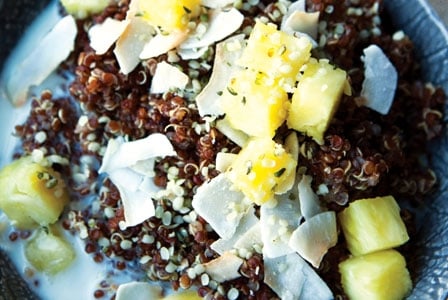
As the old saying goes, “Breakfast is the most important meal of the day”
As the old saying goes, “Breakfast is the most important meal of the day”. Not to belittle lunch or dinner, but research does indeed prove that carving out enough time for a nutritious meal before tackling the day can bestow numerous health benefits.
Case in point: Australian researchers recently determined that adults who skipped breakfast had a higher risk of heart disease than their peers who ate a morning meal.
A comforting bowl of cereal can be the anchor of a healthy morning repast. Today there are numerous nutrient-packed whole grains ready to take breakfast cereal to a whole new level. Quinoa, rice and spelt—grains that are usually a part of lunch or dinner—can easily be turned into satisfying, nutritionally charged bowls of deliciousness.
Recipes
- Tropical Quinoa Cereal
- Maple Strawberry Bulgur Porridge
- Almond Apple Millet Cereal
- Spelt Blueberry Porridge
- Coconut Black Rice Cereal
Embrace the box
For days when we just don’t have time to throw together a pot of steamy whole grains, opt for a healthy choice from the cereal aisle. Here’s what to look for when choosing a good quality cereal to start your busy day off right.
Fibre
A high-fibre diet has been linked to a reduced risk of heart disease. Choosing a cereal with just 7 g of dietary fibre per serving provides us with 28 per cent of our daily recommended intake.
Whole grains
Whole grains in the diet may reduce the risk of heart disease too. Read the label carefully, and look for the word “wholegrain” on the label and in the ingredient list. Avoid products made with refined grains.
Low added sugars
Sugar can be accounted for both in the Nutrition Facts label and in the ingredients list. Dried fruit is an excellent source of vitamins and minerals; however, it may increase the total sugar content found in the Nutrition Facts label. Ensure the sugar is coming mainly from the dried fruit by checking the ingredients list to determine whether there is added sugar.
Organic
Avoid exposure to synthetic pesticides, hormones, antibiotics and fertilisers, as well as genetically modified ingredients, by choosing cereals labelled as certified organic.
Minimal packaging
Do you ever open a brand new box of cereal and realise it’s only half full? Look for boxes that feel heavy for their size and boast post-consumer recycled materials. Better yet, look for cereals packaged only in BPA-free bags, without the added cardboard bulk.
Great grains
Use these whole grains to stir up your breakfast.
Black rice
You probably already know brown rice is a healthier choice than its processed white counterpart, but new research suggests black may trump all. Striking Chinese black rice, also called “forbidden rice” because lore says it was reserved for emperors to promote longevity, contains especially high levels of antioxidants, including the same anthocyanins found in blueberries, according to an investigation by scientists at Louisiana State University Agricultural Centre.
When ingested, these anthocyanins protect cells against oxidative damage by disarming free radicals. For a breakfast cereal, black rice works particularly well with Asian and tropical flavours such as coconut, mango and ginger.
Spelt
The ancient grain spelt is a distant relative of wheat. It’s generally easier to digest and is more nutrient dense. This nutritional giant provides laudable amounts of protein, magnesium, niacin and dietary fibre. Consuming a fibre-rich breakfast cereal in the morning helps fill you up so you are less likely to raid the vending machine come mid-morning.
Spelt flakes, which are produced by steaming the spelt kernels and then passing them through a roller, are quicker to cook and can be used like oats, making them a perfect addition to breakfast.
Millet
Not just for the birds, millet is a small, yellowish round grain that looks much like couscous. Similar to other whole grains, it has notable levels of an array of nutrients including manganese, thiamine, copper and magnesium. People who consumed the most magnesium were about half as likely to develop diabetes over a 20-year period as subjects who took the least magnesium, according to researchers from the University of North Carolina.
Quinoa
Quinoa is all the rage these days—and for good reason. Among the many nutritional highlights of this South American grain are impressive amounts of magnesium, folate, iron, copper, phosphorus and a full complement of essential amino acids, making quinoa a vegan source of complete protein. In addition to the more customary white variety, gluten-free quinoa also comes in red and black hues.
Bulgur
A popular staple in the Middle East, where it’s used to make tabouli and pilafs, bulgur is made from wholegrain wheat kernels that have been parboiled and cracked, which speeds up cooking time—a definite bonus during time-strapped mornings.
A single cup serving delivers 8 g of fibre. High intakes of fibre—about 30 g per day for men and 25 g for women—may reduce the risk of mortality from cardiovascular disease by nearly 60 per cent, according to 2011 findings in the Archives of Internal Medicine. A medium-grind bulgur produces the best results for cereal.

